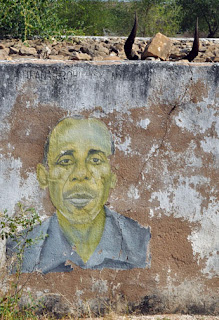Started into the Andasibe Forest at the ungodly hour of 7 am with the understanding that the wildlife is more active at that time. I was ready for anything, doused in DEET and even bringing along a rain poncho.
It was overcast this morning and humidity was dropping off the leaves….along with leeches. God I hate those things, skinny little inch-worms that land on your collar and then go for your neck. Leeches may be as close as I get to having a phobia. If I translate the French name they use for them here, it’s “blood suckers.” The only thing that moderated my dislike was that we were walking through what was virtually a glade of some species camellia.
We walked for a while through several groups of birds, stopping to ID some I’d already seen. My guide here, Pascal, will soon get a bead on what I’m interested in, but for the time being, I went along in pausing for birds I wasn’t overly interested in. We followed a path along a small river and eventually came to a little bundle of lemurs tucked in fork in a tree. Turns out they’re a nocturnal species, Wooly Lemurs, and all I saw were three little heads pop up and blink a few times. I left them alone. Pascal told me that lemurs are highly territorial, but the diurnal and nocturnal species’ territories overlap. The day shift will forage quite happily, then when they go to sleep, the night shift moves in. There’s no real contest between them.
This second-growth forest is quite thick, and I especially like the tree ferns and the huge, agave-looking plants peppered throughout. Those plants lend the forest a very unique feeling, especially when coupled with the epiphytes and orchids throughout. It’s only here that I found out that the bird’s nest fern is an epiphyte; they’re huge here. And I find this forest noteworthy for the large about of fruit in it and for the lack of thorny things.
After we went on for some time, we came on a group of Diadem Sifakas in the top of some especially tall trees. I couldn’t make out much about them except the fact that they’re a light golden color and, like all lemurians (it’s a real French term), they are as cute as buttons. These sifakas were grazing away, their golden butts glowing against a now-blue sky, occasionally jumping from one tree trunk to another. Nothing small about these guys. I stayed with them awhile.
We ran into yet another family shortly, and we stayed with them a bit, too. The light was better on them, but I still couldn’t get a photo to do their beautiful color and cute faces justice. They’re quite happy hanging around munching on fruit in the tree tops while humans pad around below.
We soon came upon the stars of Andasibe, the Indri. There are many fascinating things about this animal, the first being its looks. Indri are about 3’ tall, the biggest lemurian, and they’re light-colored, like their cousins, the Diademed Sifaka. They hang out in family groups of 4-5, with the older ones striking out on their own after a few years, and they only give birth every couple of years. Also, they eat the leaves, fruit and flowers of a variety of trees, but they only browse indigenous ones. They’re an endangered animal with the 60 or so troops here in Andasibe being the only population in the world. Indri can’t be kept in captivity; they quit eating and die when taken out of the forest or confined.
As if that weren’t enough, the call of the Indri is one of the eeriest sounds in any rainforest anywhere. They have a call that resembles the human voice in tone, but it’s high and seems to have some harmonic element to it. It’s terribly loud and can carry for over a mile. When they call, it sounds almost like a whale song. And the group I was watching decided to call. The sound was deafening as these guys clung to their trees and opened their little red mouths to emit their piercing wail. What an experience to be right in the middle of that.
We walked a few more hours in the agave-accented rainforest, checking out a Madagascar Jumping Rat hiding in a hole in a tree and spotting a group of Brown Lemurs. Several flocks of parrots flew by, but we didn’t get a good look at them. We saw, however, several Madagascar Mannikins snipping the seeds off some tall, sunny weeds, looking for all the world like what must be their close relative, the sparrow. And as we turned onto the path that led to the ranger station, we saw a tight little France’s Sparrowhawk sitting on a wire over the path, waiting for a chance to pounce on a grasshopper or mouse. Another endemic.
We made our plans for tomorrow with Pascal, and Solofo and I headed to the fancy Andasibe hotel for lunch. I’d hoped for some Malagash cuisine, but they didn’t have it! Alas, it was zebu and frites again….and the zebu was so undercooked that I sent it back to the kitchen. Driving past a field on the way back, we stopped to watch a Common Stonechat doing a flycatcher move by snatching bugs out of the air and returning to its perch.
The rest of the day was playing around the hotel, sitting on the porch of my bungalow and looking into the forest on the other side. Looking forward to a long walk tomorrow in the primary forest. I will have to get Pascal to pick up the pace some, though.




































